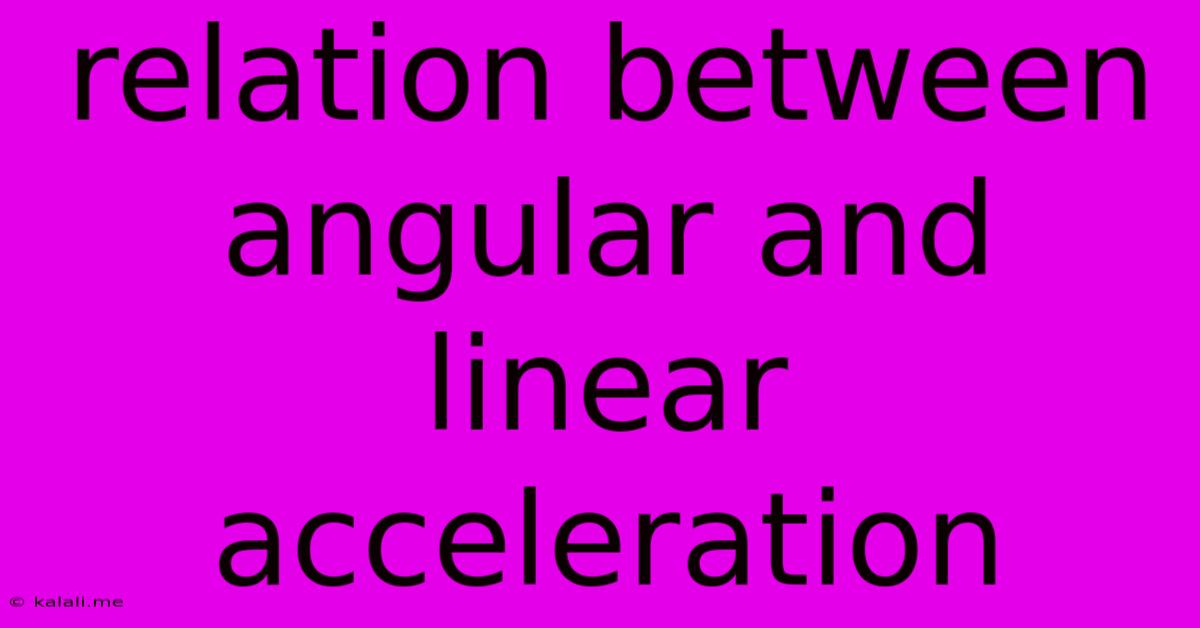Relation Between Angular And Linear Acceleration
Kalali
Jun 16, 2025 · 3 min read

Table of Contents
Understanding the Relationship Between Angular and Linear Acceleration
Understanding the relationship between angular and linear acceleration is crucial for comprehending rotational motion. This article will delve into the connection between these two concepts, explaining how they are related and providing practical examples. It will cover tangential acceleration, centripetal acceleration, and how they contribute to the overall linear acceleration of a rotating object.
What is Angular Acceleration?
Angular acceleration (α) measures the rate of change of angular velocity (ω). Angular velocity describes how fast an object is rotating, measured in radians per second (rad/s). Angular acceleration, therefore, is measured in radians per second squared (rad/s²). A higher angular acceleration indicates a faster increase in rotational speed. Think of a spinning top speeding up – its angular acceleration is positive. Conversely, a spinning top slowing down has a negative angular acceleration.
What is Linear Acceleration?
Linear acceleration (a) measures the rate of change of linear velocity (v). Linear velocity is how fast an object is moving in a straight line, measured in meters per second (m/s). Linear acceleration, therefore, is measured in meters per second squared (m/s²). This is the acceleration you experience when driving a car and pressing the gas pedal.
Connecting Angular and Linear Acceleration: The Role of Radius
The crucial link between angular and linear acceleration is the radius (r) of the circular path the object is following. Consider a point on a rotating object like a spinning wheel. This point experiences both angular and linear acceleration. The relationship is defined by the following equation:
a = αr
where:
- a is the tangential linear acceleration (m/s²)
- α is the angular acceleration (rad/s²)
- r is the radius of the circular path (m)
This equation tells us that the tangential linear acceleration is directly proportional to both the angular acceleration and the radius. A larger radius or a larger angular acceleration will result in a greater tangential linear acceleration. This tangential acceleration is always directed along a tangent to the circular path.
Centripetal Acceleration: A Component of Linear Acceleration
While tangential acceleration describes the change in the magnitude of linear velocity, centripetal acceleration (a<sub>c</sub>) describes the change in the direction of linear velocity. Even if an object is rotating at a constant angular velocity (ω), it still experiences centripetal acceleration because its velocity vector is constantly changing direction. This acceleration is always directed towards the center of the circular path. The formula for centripetal acceleration is:
a<sub>c</sub> = ω²r
where:
- a<sub>c</sub> is the centripetal acceleration (m/s²)
- ω is the angular velocity (rad/s)
- r is the radius of the circular path (m)
Total Linear Acceleration
The total linear acceleration of a point on a rotating object is the vector sum of the tangential acceleration and the centripetal acceleration. This means you need to use vector addition to find the total linear acceleration. If the angular velocity is constant, the total linear acceleration is simply equal to the centripetal acceleration. If the angular velocity is changing, both tangential and centripetal acceleration contribute to the total linear acceleration.
Examples
-
A spinning merry-go-round: As the merry-go-round speeds up (positive angular acceleration), a child sitting on the edge experiences increasing tangential acceleration. They also constantly experience centripetal acceleration pulling them towards the center.
-
A car accelerating around a curve: The car's angular acceleration (around the curve's center) translates to tangential linear acceleration, while the centripetal acceleration keeps the car moving in a curved path.
Conclusion
The relationship between angular and linear acceleration is fundamental to understanding rotational motion. By understanding the equations relating angular acceleration, radius, tangential acceleration, and centripetal acceleration, one can fully describe the motion of any point on a rotating object. This knowledge is crucial in various fields including physics, engineering, and robotics.
Latest Posts
Latest Posts
-
How To Create Clickable Image In Html
Jun 16, 2025
-
What Are The Factors Of 121
Jun 16, 2025
-
What Is A Theme Of The Passage
Jun 16, 2025
-
A Company That Provides Access To The Internet
Jun 16, 2025
-
Which Word Is Closest In Meaning To The Underlined Word
Jun 16, 2025
Related Post
Thank you for visiting our website which covers about Relation Between Angular And Linear Acceleration . We hope the information provided has been useful to you. Feel free to contact us if you have any questions or need further assistance. See you next time and don't miss to bookmark.